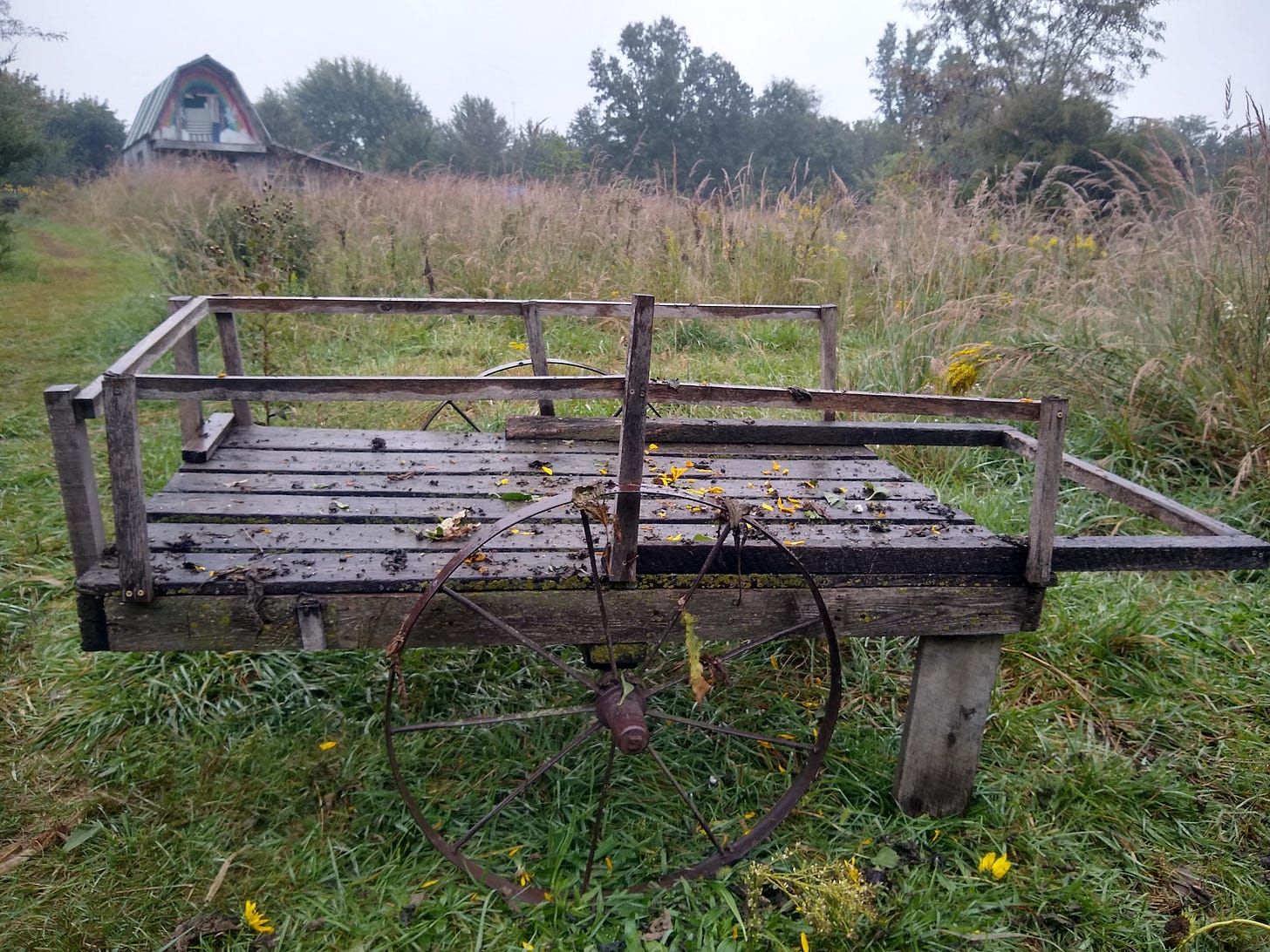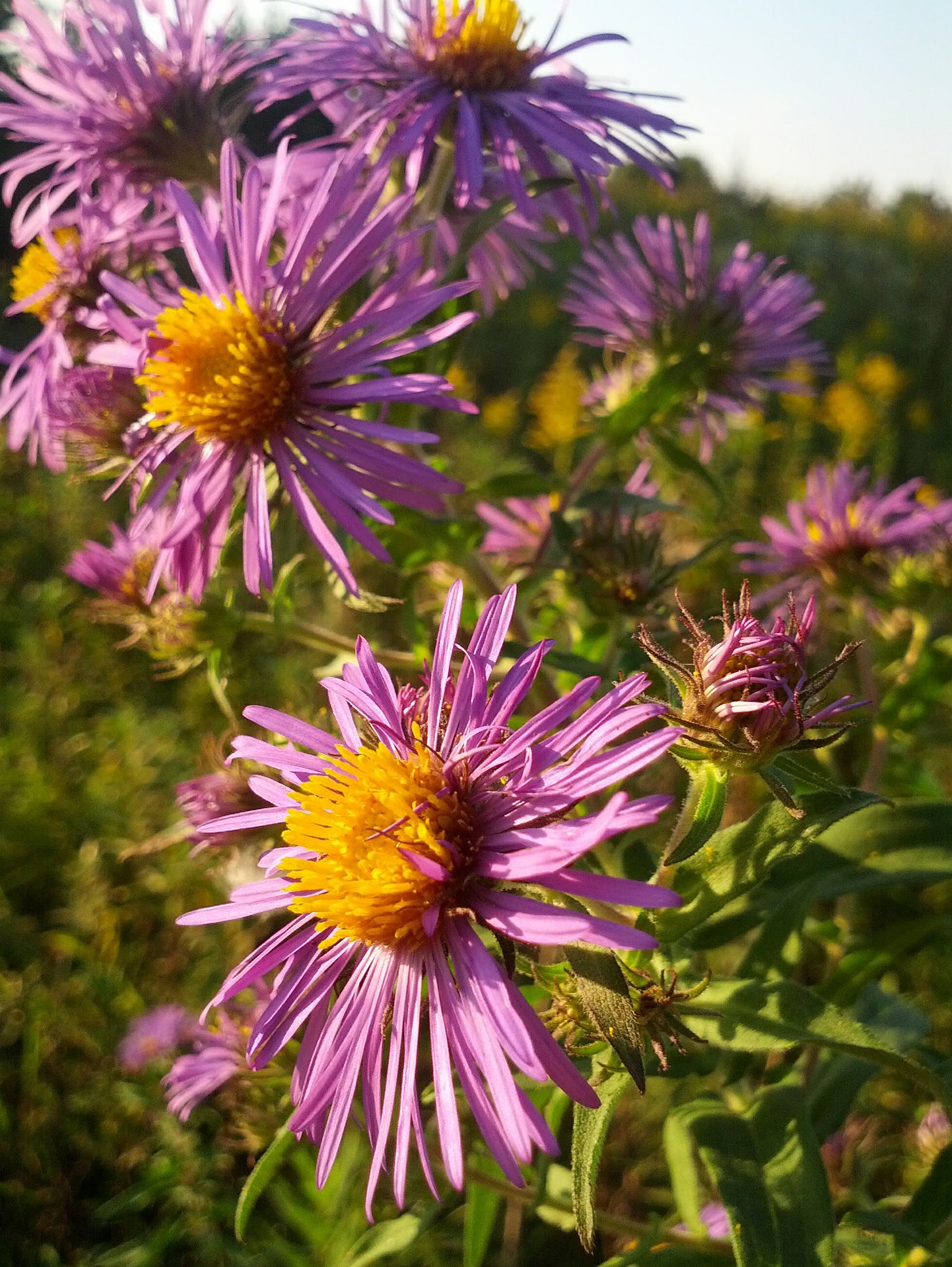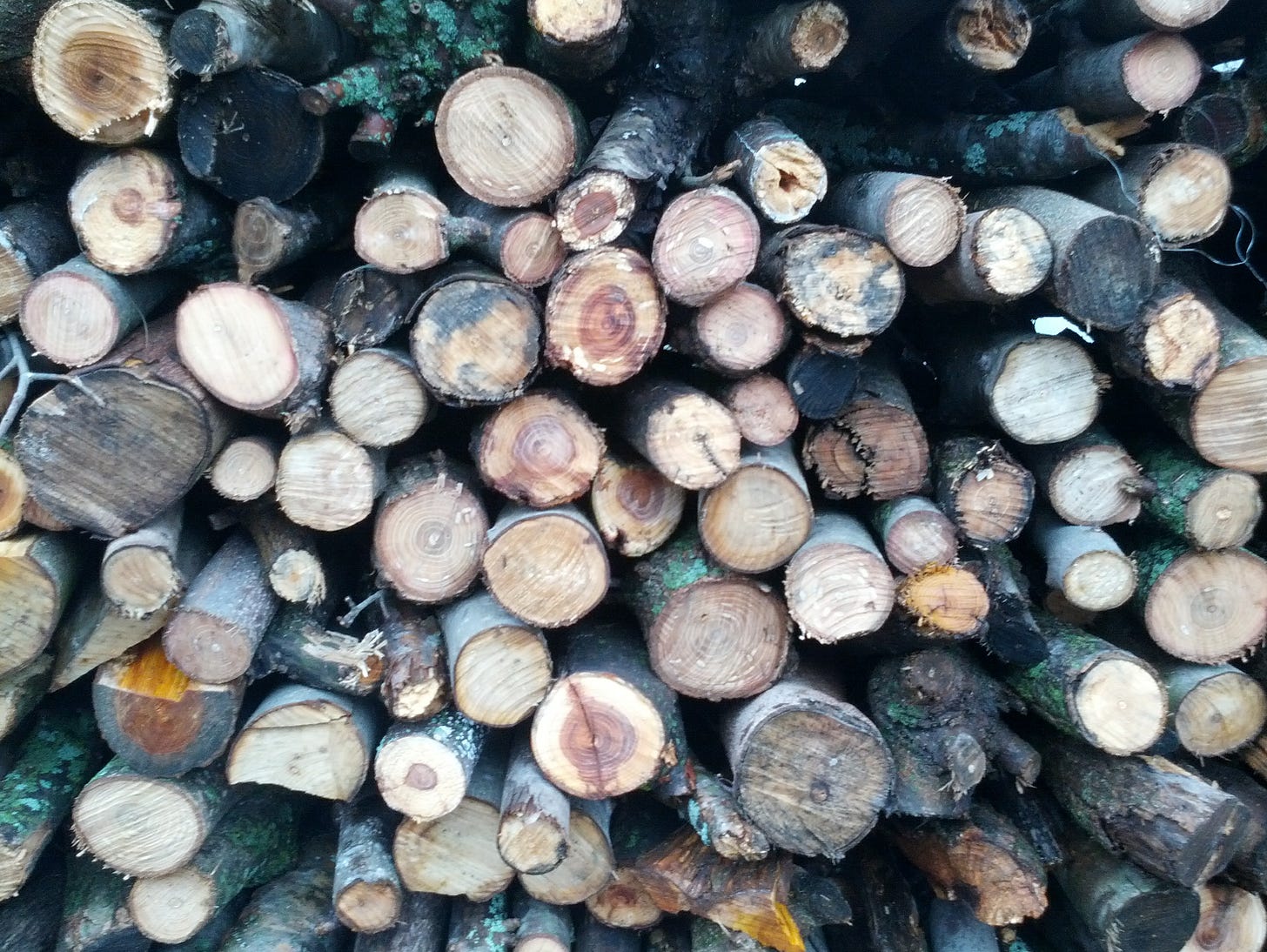Homecomings
Phloem, petrichor, hawk kettles, and woolly bears
Some days ago, swarms of broad-winged hawks (Buteo platypterus) crossed over us on their way back from their seasonal breeding grounds down to their tropical winter homes across Mexico and Central and South America. As thousands of raptors contract toward warmer climes and long-lived sun, they soar over these broad plains of receding prairie drying to honey, gold and ocher, gradually replaced with cul de sacs and Dollar Generals and millions of bushels of corn running through combines, swirling skyward in cyclonic kettles, loose groups of spiraling birds of prey which rise on thermal columns and pirouette back to earth to perch overnight on their sojourn of thousands of miles. Like feathered and taloned tornadoes they spin and dance on the sky, heaving and wobbling, threatening to meet the earth one moment and then careening upward and away, our nervous poultry alert and concerned ‘neath the shelter of hedge, elm, and mulberry. These faint storms of broad-winged hawks resemble the far-off plumes of Missouri trash fires that rise from the middens of old farm-lots on high bright autumn days, rising like burnt out embers on unseen heat and dropping like the wind-torn leaves of tired cottonwood.
The migration of Buteo platypterus is an awesome sight, but fairly well understood… not so much Cyanocitta cristata– more commonly known as the blue jay. Generally, blue jays are year-round denizens of their territory, spending autumn and winter feasting on acorns, and eating more omnivorously during the spring and summer. That said, some minority of blue jays do migrate, mostly younger birds. These migrations take place along the Atlantic coast and the Great Lakes, but ornithologists are not completely clear on their motivations. It could be related to food abundance, but without a deeper level of tracking data, we don’t really know. I have seen some fairly large groups of jays flocking to windblown stands of pin oak, cawing and screeching as the small acorns trickle to the forest duff, maybe numbering a couple dozen. It is hard to know if these groups are stopping over on longer travels, or if they’ve been in our dense growth the whole time, waiting for the pitter patter of fresh nut meats down in the draws and bottoms.
I write this in a turn of the century (that is the 19th century turning to the 20th) school desk out under a matriarchal hedge tree that has begun to slough off a few yellowed leaves. It may be meteorological autumn, but the canopies mostly hold a tired verdancy of battered and torn foliage. The elms are ragged and the mulberries skeletal in some places, their tender leaf stems releasing early in the season, and most of the honey locust is nearly bare of limb, excepting the twisting spirals of chocolate-brown pods that rattle in the northerly wind. Above me, a few pendulous hedge balls dangle on tenuous stems, the fruit of Damocles, threatening to pound this thin, strange device of plastic and glass and silicon into the sort of dumb oblivion that probably suits it, and me. Instead, hedge fruit thuds a few feet off, sparing my computer as it rolls through the thickening layer of fall detritus beneath my feet, emitting a musky, complex sweetness.
It has rained here some, after what has been a long, dry September, and with rain, comes petrichor, the name given to the earthy, pleasant fragrance emitted after the arrival of long-awaited precipitation. Petrichor is a complex smell– partly the result of geosmin, a compound secreted by soil-dwelling bacteria, along with plant oils that are released by mechanical battering of the rain, ozone from lightning, and the smell of water itself. A romantic yet familiar essence, petrichor is a difficult odor to capture, synthesize, or distill, and as a commercial scent is highly prized and priced accordingly. I imagine a dismal future in which rain is so scarce that commercially synthesized petrichor is the only available cure for a nostalgia made painful.
For now, I still have access to the real stuff, and I take in big whiffs of it while kicking around along the windswept hedgerow with my dog, grasping the protruding arcs of windfall branches to find kindling seasoned enough to break up and store up for some heat and illumination in the coming darkness. The pup, in an apparent attempt of helpfulness, pounces and paws at the dead limbs, cracking them in her toothy maw. The hawks spiral up and out on columns of hot air and swoop nearer their earthly habitat on the cool downdrafts, as do I, in this time of homecoming. Jar by jar the garden’s provisions fill pantry shelves– tomato sauces, dehydrated okra, pickled beans, fermented hot sauce and pounds of dried cowpeas. The gifts of the garden and field given in summer’s extroversion, all sugar and vitamin and color, return to the roots of their creation, and soon our mouths and guts. It is homecoming season, the time of phloem, when those products of a season spent photosynthesizing are transmuted to become the preserved nourishment in the coming dormancy.
In the aftermath of late summer’s spectacular fireworks show on the prairie, after the explosions of hot pink bee balm and vibrant purple ironweed have faded into the ashen chaff of dull seedheads, and the once-profuse fountains of goldenrod wash out like faint trails of smoke, the subdued and tired landscape still has a bit of glimmer left before the cold sweeps in to stay. Like the falling, fading sparks that crackle incandescent after the grand explosion of pollination and photosynthesis and color that is a prairie in full flower, New England aster (Symphyptrichum novae-angliae) heralds the afterglow of summer, and tolls the somber knell of death’s springtime.
Yes friends, death, like the cawing jays of the wood, may have never left this place, but as the limbs and boughs of elm and mulberry grow nude and dormant in the north wind, death now makes itself known. The seeds on the sorghastrum grass no longer glisten their natal gleam but stand sleeping at the nodding ends of tired steams, awaiting the reaper, in our case, the gaping beaks of fattening fowl. The pasture thins out, never to refill ‘til the return of springtime warmth. The spiral out becomes the spiral in, xylem begets phloem, and the circle closes as we prepare the plant the slumbering earth with bone and blood.
Death has never left these fields, but while once it stalked their edges, rustling in the cover of brambles, it now threatens to enshroud us fencerow-to-fencerow as the long nights settle in. The turnips have swollen, their bloating stems stocked with energy for the long dark. Elms tuck their roots deep ‘neath a quilt of petrichorous leaves. Tubers of sunchoke grow fat in the earth that has fed us, and now, we must feed it.
We have brought a few boxes of firewood nearer the house in anticipation of our first fire. Stacked on the dry and sunny west side, they are quickly becoming home to bristly, loping woolly bear caterpillars (Pyrrharctia isabella), the larval form of the Isabella tiger moth. It has long been purported, in this region and others, that the woolly bear can be used as a weather predictor. The woolly bear appears to wear a fuzzy, striped sweater, often with a rust-brown central band, and two black ends. It is said that the wider the black bands, or inversely, the wider the brown band, the more treacherous our winter will be. If the head of the caterpillar is darker than the tail, the early winter will be harshest, and vice-versa. This caterpillar is allegedly segmented into 13 pieces– each correlating to one week of winter. The fuzzier the woolly bear, the colder it will be, and a mild winter is predicted if they travel in a northerly, rather than southerly fashion.
Naturally, fun as this all is, woolly bear forecasting is technically bullshit. These caterpillars actually molt through several stages of larval development, lengthening at their ends. The longer the vegetative season and with an abundance of caterpillar forage (grass, plantain, and nettles being among their favorite browse), the black ends of the woolly bear expand. If anything, these critters will do a fine job of summarizing the prior year in terms of vegetative growth. I looked at a few, but the other thing to bear in mind is that there are about 260 different variations on tiger moth larvae, some of them are all black, or all brown, and at the end of the day I probably have a better sense of what the weather has been by means of memory and pure observation than I do staring at fuzzy little caterpillars.
Our turkeys strut and scamper under acorn rains in the draw, and fattening swine snuffle through the dew to crunch and crack the accumulating mast. Skeins of geese drift south and the prairie, heavy with seed, slumps to earth. Far from the madding crowds of cider-choked autumn tourists, bloated with pumpkin spice kicking through the leafy duff like pale worms, the rolling hills of Northeast Missouri instead don a welcome, if dark, silence, punctuated only by the whine of combines, and the howl of encroaching coyotes. The front porch pumpkins will soften on empty porches, the pots of chrysanthemums will wither and gray, and on frosty dawns we will soon reap flesh and fat from the sleeping landscape, flecked red with blood and purple with frozen asters, a funeral arrangement made for the shrinking sun.
Darkness may descend like the earthward spiral of tail-spinning hawks, but for now, there is still plenty of bustle. It is fine weather to transplant a few paw paws and persimmons we sprouted, and before the week is out I will mix and apply a repair coat of earthen plaster to the worn edges of our humble straw-insulated dwelling. I’m sitting in my school desk in the shifting dapple of windblown hedge, and familiar calls echo from the limbs, flickers and nuthatches and wrens and cardinals and towhees all alighting a moment before provisioning sustenance for the dwindling days ahead. I do not need to poke at caterpillars to understand that our path forward will be trying, the night will grow long, and that death is inevitable.








I love reading about the landscape that I walk through everyday, elevated to poetic description. And in addition, you lift up layers of that landscape to teach about the nature systems going on, that one can't necessarily observe directly.
Poetry.
Poetry born of paying attention to one’s natural surroundings.
Poetry of the prairie.
Poetry of the changing seasons.
Poetry of life and death.
Thank you.